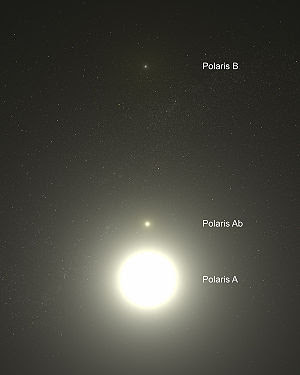Beatles in Space
At 7 pm on 4 February 2008, NASA beamed the Beatles' song "Across the Universe" toward Polaris (the North Star) 431 light years away via NASA's Deep Space Network. This was done to celebrate several anniversaries that occurred in the first week of February 2008:
- 5oth anniversary of the founding of NASA
- 50th anniversary of the founding of the Beatles
- 50th anniversary of the launch of the first U.S. satellite, Explorer I
- 45th anniversary of the founding of the Deep Space Network
- 40th anniversary of the production of the first version of the Beatles "Across the Universe" by George Martin.
A Moot Question?
As mentioned in an earlier post, on one hand the question whether we should or should not send a message into space for aliens to detect may be a moot point as we've been leaking radio and TV signals into space for over 60 years now. And the amount of signals we're leaking out into space has increased. However, weakly leaking out man-made radiation isn't the same as purposely beaming out a strong focused signal into deep space.
The chance that there is, or will be by the time the signal reaches it, a technologically advanced sentient alien race who are not only able to detect the signal and understand that it is artificially produced, but who also just happen to be listening with their electronic ears pointed toward our region of space at the right moment to pick up our one "Across the Universe" transmission is rather minute.
Possibly decreasing the chances even further is the nature of Polaris. It is a Cepheid variable star in a triple-star system. A Cepheid variable is a star 5 - 20 times the mass of the Sun that regularly cycles between expanding and contracting in size. This may impact the stability of the habitable zone for the star system.
Finally, the chance of an alien space probe (not necessarily from Polaris) happening across our transmission beam, or for another sentient race around a star beyond Polaris detecting the beam is also rather minute (even astronomically minute).
The Problem of Blasting Music toward Your Neighbors
So what's the problem with introducing the Beatles to the Polarians, and whoever else may hear it after them?
We do not know the nature of the Polarians, or of any alien that may intercept our message. We do not know how they will react to it. Too often on Earth, when a technologically advanced civilization meets (or "discovers") a less advanced civilization, it usually ends up disastrously for the less advanced one. This does not mean that the aliens would behave the same way, but it does point to the distinct possibility that they could. If we can, others can - I seriously doubt that there is a universal natural law that only one arrogantly aggressive sentient race can exist in a galaxy.
The aliens may be xenophobic because they were invaded once themselves by an alien race, and their leader(s) decide that it is better to do preemptive strikes. Or maybe their world leader is a megalomaniac who isn't satisfied with ruling just one planet. Is it impossible for someone to want to try to rule the galaxy, even if that is a deluded desire? Or the aliens may have a religious reason to attack, one that we can not fathom. The aliens may misinterpret our message as one of aggression or of grave insult to their faith, leader, or way of life.
Or they may want to come and "help us" - parent us. They may feel it is their inherent right to do so. Some imperialistic nations in Earth's history had that philosophy - they conquered other nations to help them. They may see us as uneducated, lost heathens who need to be shown the light, and they know, from experience with other planets or their own history, that heathens won't listen unless you use "tough love" on them.
Technological advances do not always come with the appropriate advances in culture or society. A technologically advanced alien race does not have to be morally advanced as well (though one sentient species morality may not be the same as another's).
Yes, there is also the chance that the aliens that happen to hear our transmission will respect our sovereignty in all aspects of our world. They may be merely knowledge seekers, explorers, curious to learn more about us, and nothing more.
Or the aliens may even be rather indifferent to us, like the aliens in Dan Abnett's short story "Point of Contact" (found in The Solaris Book of New Science Fiction
We just do not know. Is it worth the risk to announce ourselves?
Ah, but, you may say, at 431 light years away are we not safe?
Vast Distances, Like Fences, Good Neighbors Make?
It would be if the speed of light is the fastest any one can travel, and the aliens are short lived as we are and are adversed to multi-generational space journeys. Recent research over the last 15 years shows that "warp drives" may be possible one day after all. A more technologically advanced civilization than ours may have figured out warp drives.
Such an advance in spaceflight technology could make moot another related barrier - long interstellar distances can, with sub light spaceships, take many generations to traverse. This, of course, assumes that an alien race has short life spans like ours. With great medical advances, and their own different biology that may allow longer life spans to begin with, it is not inconceivable that an alien race could live long enough to make the trip to Earth and back in one generation or less. Of course they would have to be able to deal with being cooped up in the small (compared to the open air or water of their home planet) spaceship, as well as be able to produce enough sustenance and breathable atmosphere. But again, faster than light travel would take care of most of those problems.
Another barrier to traveling interstellar distances is the danger of cosmic radiation. It is difficult to shield from it. Our atmosphere is thick enough (60 miles) to protect us, but out in space, travelers just have the skin of their spacecraft. Though researchers are looking into creating magnetic bubbles around spacecraft to protect the humans within it from cosmic radiation. So that is probably not a problem for a more technologically advanced space faring civilization.
They, Robot
However, even if an alien race is too far away to send some of their own out to travel to Earth, they could send robots in their place. Sending robots solves many problems - no need to grow food, maintain a breathable atmosphere, or worry about the trip taking generations. Robots would also be able to explore a greater variety of planets as they would be able to tolerate a far wider range of physical environments as well as be essentially immune to any alien virus or bacteria. They could even be more resistant to attack from many biological creatures. This is one reason why some ufologists believe that the aliens known as "Grays" are actually advanced robots.
The robots would need to have sufficiently sophisticated AI (Artificial Intelligence) though, so that they can operate mostly on their own due to a 862 year round trip for any communications - unless the aliens are able to develop something akin to subspace communications like in Star Trek (would such robots be sentient?). Of course, if their mission is simple, like "observe from a distance, take notes and report" or "destroy all humans," there wouldn't be a great need for two way communication. Just sending reports updating on their progress (either to the home planet, or to a second wave of robots coming after them so that they can adjust their game plan if need be before arriving at Earth).
"Nothing's going to change my world..."
Outro
The irony of it is, the song could change our entire world by its being beamed into space by a radio telescope. Yes, I know that what John Lennon means is that when you achieve a pristine state of consciousness, you are in a mental and spiritual state where you are free of worldly distractions: "Nothing's going to change my world..." However, if, and it is a big if, the song does get the attention of aliens, most of us will find our worlds changing as most of us haven't reached the mental and spiritual state sung about in the song.
What do you think about this?
Some additional information about the Polaris star system
Like most triple star systems, the Polaris system contains a close binary with a more distant star circling the binary.
In the Polaris system, the central binary pair is made up of Polaris A, the giant Cepheid (somewhere between 4.3 to 5.4 times the mass of the Sun), and Polaris Ab, a dwarf star (1.4 solar mass).
Polaris A is the brightest Cepheid as seen from Earth. Polaris Ab circles Polaris A in a highly eccentric orbit, with the distance between it and Polaris A varying from 27 AU to 6.7 AU, taking over 29 years to orbit Polaris A (about the time it takes Saturn to orbit the Sun).
Comparing those distances to our solar system, Pluto's closest approach to the Sun is 29.7 AU, and Jupiter's furthest distance from the Sun is 5.5 AU. By the way, recall that while Pluto is further away than Neptune, on average, it has a much more eccentric orbit than Neptune and thus actually can be closer to the Sun than Neptune.
The third companion, Polaris B, is a main sequence Sun-like star (1.1 to 1.25 solar masses) which orbits some 2400 AUs from the center binary pair, or 60.8 times the distance from our Sun to Pluto (at its furthest point in its orbit). It takes Polaris B 29,000 years to orbit Polaris A.
References:
"About the Deep Space Network." Deep Space Network Home Page. NASA's Jet Propulsion Laboratory. 20 Mar. 2008. Web. 11 Aug. 2008. <http://deepspace.jpl.nasa.gov/dsn/>.
Borland, John. "Physicists Do the Math on Warp Drive Science." Wired Science. Wired News. 14 Dec. 2007. Web. 11 Aug. 2008. <http://blog.wired.com/wiredscience/2007/12/physicists-do-t.html>.
"Cepheid Variables - Introduction." Imagine The Universe! NASA Goddard Space Flight Center. Web. 11 Aug. 2008. <http://imagine.gsfc.nasa.gov/docs/science/mysteries_l1/cepheid.html>.
Kaler, Jim. "Polaris." Stars. University of Illinois. Web. 11 Aug. 2008. <http://www.astro.uiuc.edu/~kaler/sow/polaris.html>.
Knight, Will. "Repelling cosmic rays with magnetic bubbles." New Scientist.com news service. 19 Nov. 2004. Web. 11 Aug. 2008. <http://www.newscientist.com/article.ns?id=dn6694>.
"NASA Beams Beatles' 'Across the Universe' Into Space." NASA. 5 Feb. 2008. Web. 11 Aug. 2008. <http://www.nasa.gov/topics/universe/features/across_universe.html>.
Nave, Carl R. "Solar System Data." HyperPhysics. Georgia State University. 2006. Web. 11 Aug. 2008. <http://hyperphysics.phy-astr.gsu.edu/hbase/solar/soldata2.html>.
Tytell, David. "Probing Polaris." News from Sky and Telescope. Sky and Telescope. 10 Jan. 2006. Web. 11 Aug. 2008. <http://www.skyandtelescope.com/news/3311001.html>.
"Warp Drive, When?" NASA. 17 Mar. 2006. Web 11 Aug. 2008. <http://www.nasa.gov/centers/glenn/research/warp/warp.html>.




No comments:
Post a Comment